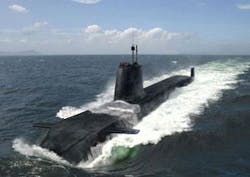Officers in the United Kingdom Royal Navy recognize the need to reduce the sonar signature of its submarines, and thereby minimize the risk of surface ships and other submarines detecting their presence.
“Submarines are most vulnerable to detection when the submarine commander uses a periscope to assess the situation on the surface,” says a representative. Engineers with the Royal Navy, therefore, sought an advanced solution, which they found at Thales U.K. in London.
The Royal Navy’s new Astute class submarines will employ Thales U.K.’s non-hull penetrating, electro-optic mast. The electro-optic system delivers extensive surface visibility without revealing the submarine’s position.
In the Thales electro-optic mast’s non-hull penetrating design, a Sensor Head Unit (SHU) extends from the submarine fin and rapidly performs a 360-degree scan above the ocean surface. The commander is then able to analyze the captured image data.
The electro-optic mast is powered by Wind River’s VxWorks mission-critical, real-time operating system (RTOS). The RTOS runs on Thales’s quad PowerPC AltiVec commercial off-the-shelf (COTS) boards and AdaCore GNAT Pro. The RTOS helps to power the stabilization system, control video and thermal cameras, enable communication with the in-hull systems, and control all the mechanisms and motors in the SHU.
The SHU, a pressure-proof, electro-optical assembly, contains high-performance cameras, optics, environmental sensors, and stabilization mechanisms.
For more information, visit Thales U.K and Wind River online at www.thalesgroup.com/uk and www.windriver.com, respectively.

